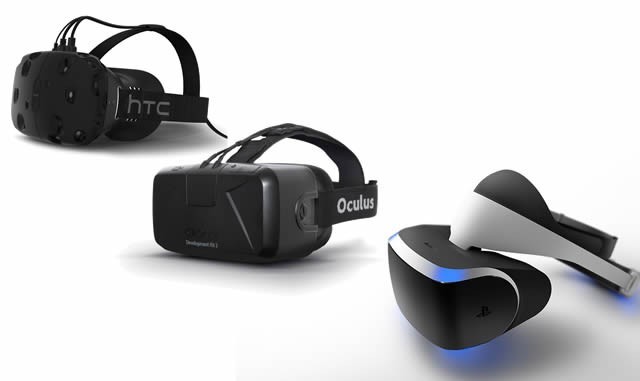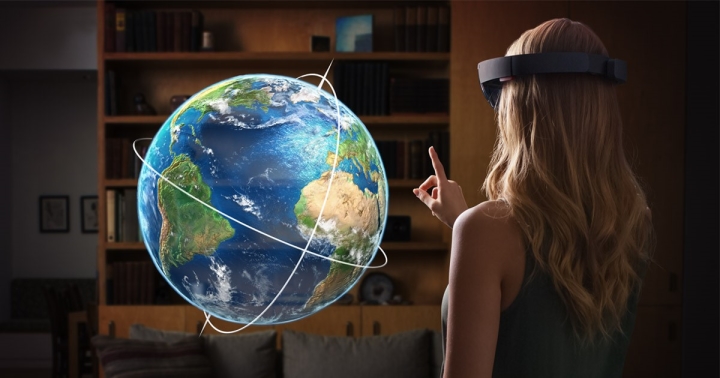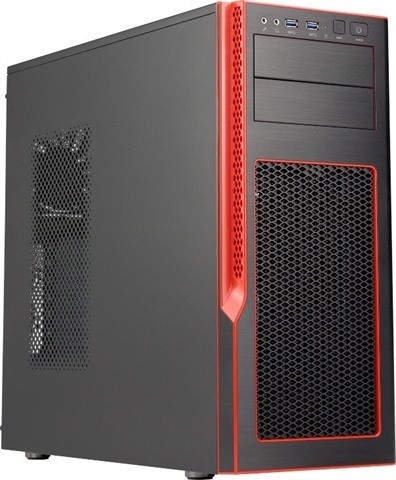2015 saw the advancement of virtual reality technologies as they gear up for consumer launch. With several players in the field, things are set to explode in 2016. When people talk about VR the context is usually gaming or other forms of digital entertainment, however, there are a number of applications for VR technology which could see some revolutionary changes in the way we work today.
At Boston we are excited about the possibilities VR could bring if it manages to hit the mainstream market for the first time. We have even done a little in house testing with the Oculus Rift running on one of our ultra-high performance Boston Venom workstations, but more on that later. First things first, we should begin by looking at the vendors that will be offering these technologies and how they differ.

HTC Vive, Oculus Rift and PlayStation VR headsets.
OCULUS RIFT
The Oculus Rift is the virtual reality headset that led the charge into this exciting new era of virtual reality, and first shipments of the final consumer version are expected in March 2016. It has seen a few iterations in the form of early developer kits which have gradually improved the quality of the technology with enhancements to the screens and motion tracking. Oculus was acquired by Facebook in 2014 for an astonishing $2bn. Thanks to this financial bakcing, Oculus have announced that they aim to release their headset at a price as close to manufacturing cost as possible. The Oculus will ship with the headset, a sensor device which tracks the headsets position and an Xbox One controller for control input. Handheld motion controllers are due for launch later in the year.
HTC VIVE
A joint venture with video game giant Valve, the Vive is taking a slightly different approach in that it strives for a full body VR experience. It will even ship with motion controllers that are fully trackable in a 3D space. The Vive platform uses a technology they are dubbing 'Lighthouse' which uses stations placed around the room to send out waves of invisible infrared lasers which are picked up by trackers on the Vive headset and controllers. This means your body position and hand gestures are fully tracked in a virtual environment. This should lead to more interactive virtual environments with increasingly accurate interactions and movement.
PLAYSTATION VR
Sony's venture into VR will likely be focused strictly on gaming and entertainment for their PlayStation 4 gaming console. Similar in concept to the other platforms, the headset will require a PS4 rather than a PC. It's interesting to note that an external processing box is required between the headset and console, something typically not used by others. Virtual Reality headsets demand a lot of processing power and whilst little is known about this external box, Sony have deemed it necessary to get some extra horsepower as the PS4 may be lacking compared to high end PC's. Currently at an earlier stage in development compared to other headsets, a final release date is not yet known but Sony are aiming to launch in the second half of 2016.
GOOGLE CARDBOARD
Google has ventured into the VR space with a simple cardboard platform. This is a basic version of VR as it requires an external device to work (mobile phone). It consists of a simple cardboard construction with lenses and an area for a mobile phone to slot into. This VR solution (the cardboard kit can be printed at home or purchased for around £10) is a bit more of a proof of concept than a full blown VR headset. In our Labs here at Boston, we like to get our hands on any new hardware, be it the latest and greatest CPU's, graphics cards or even interesting gadgets. So we couldn't resist seeing what this basic form of VR could bring to the table. Wearing one does provide a glimpse into the possibilities that VR solutions can bring and can be an immersive experience, although it is a little limited by having to run off a mobile device rather than a powerful computer. VR apps are needed for google cardboard and there are already quite a few on the various app stores, such as virtual rollercoasters and star wars videos that put you in the middle of the action.

Google Cardboard running on an iPhone 6.

Google Cardboard in action at Boston.
MICROSOFT HOLOLENS
Microsoft are taking a different approach and using a more augmented reality solution. With HoloLens, holograms are placed in the world around you through the use of the headset. Need a bespoke screen? HoloLens will project one onto any surface. Working on a 3D model design? The headset can project the 3D model in front of you ready to manipulate and design in real time. This will lead to a wide variety of uses but the technology is not as mature as the other platforms yet so we shall see how well it works in the near future.

Interacting with holograms using a Microsoft HoloLens.
THE TECHNOLOGY
As the consumer versions of these devices have not been released, the final specifications are not fully known. We do, however, have a good idea of what to expect. For the trio of headsets from Oculus, HTC and Sony a combination of a high resolution screen is used along with the lenses to give you a wide field of view. In the case of the Rift and Vive, 2 OLED screens are used with a resolution of 2160x1200 (1080x1200 per eye) and running at a 90Hz refresh rate. Of course the screen and lenses only make up a part of the overall experience. The headsets also feature tracking in order to mimic your real life movements into the virtual space. As previously mentioned, the Vive uses a room-wide tracking field to extrapolate your position. This will allow for more free-form movements as it tracks you whilst you move around a room, space permitting of course. The Oculus Rift uses a webcam-like sensor device which is placed on your desk in order to track the position of the headset in real time. It seems this makes the Rift more suitable to sitting down and using the headset, as the sensor needs to see the tracking LED's on the headset.
Microsoft's HoloLens is clearly a different technology, it used augmented reality to blend the virtual world with the real one. Wearing the headset, you will still see the real world around you. The headsets camera and sensors, powered by a CPU, GPU and what Microsoft are labeling a HPU (Holographic Processing Unit) project holograms onto that world for user interaction. As the sensors spatially map the environment, they can also recognize hand gestures and voice commands.
POWERING VR
It's pretty clear that in order to run these devices at their full potential some powerful computer hardware is required. The Rift and Vive need 2 screens rendered in high fidelity and Oculus recommend developers aim for content to run at 90 frames per second. This is to maintain fluidity and believability as lower frame rates will undoubtedly lead to a poor 3D user experience. So users will certainly need to have a modern and fast CPU and powerful GPU to get started.
A potential user of an Oculus Rift, for example, will need a PC with at least an Intel core i5-6400/i5-4590 CPU, 8Gb of RAM, 3x USB 3.0 and 1 USB 2.0 ports, HDMI 1.3 video output and at the very least a NVIDIA GTX 970 or AMD 290 GPU. Developers will also need cutting edge hardware to develop content for the next wave of VR computing.
At Boston we offer a range of products that cater to the different needs and requirements of both developers and users, namely the Boston Venom series of professional workstations.
BOSTON VENOM PROFESSIONAL WORKSTATIONS
 The Boston Venom range are a series of often liquid-cooled, GPU-accelerated workstations and servers, built on Supermicro hardware. Designed to cater for wide variety of applications from media and entertainment to science, we use cutting edge components to deliver extremely powerful CPU and GPU options to fit each use case perfectly.
The Boston Venom range are a series of often liquid-cooled, GPU-accelerated workstations and servers, built on Supermicro hardware. Designed to cater for wide variety of applications from media and entertainment to science, we use cutting edge components to deliver extremely powerful CPU and GPU options to fit each use case perfectly.
Using liquid cooling allows head room to overclock processors and achieve low latency and higher performance than stock. For example, the 2500-0P model delivers an Intel Core i7 5960X processor with 8 cores at an enhanced 4.1GHz clock frequency, yet keeps the thermals easily under control. Paired with an NVIDIA Titan-X graphics card, the 2500-0P offers superb performance and will handle anything VR can throw at it. Designed for 'work and play', this powerful workstation is versatile in the number of graphics based tasks it can take on without breaking a sweat.


For those even more power hungry digital content designers out there, a Venom workstation such as the 3401-7T is more catered to your needs and requirements. Powered by 2 overclocked Intel Xeon E5-2687W V3 CPU's and NVIDIA's Quadro K5200 GPU, the 3401-7T is suited for professional designers such as those working on cutting edge VR games and applications, media editors and CAD.
VR APPLICATIONS
Whilst the headsets featured here will no doubt be initially focused on gaming as that's currently where the market for these products lies, I believe there will be many other uses for the technology in the future. Let's take a look at some of these below.
Architecture and 3D Design
As previously mentioned, we had the chance to get our hands on an Oculus Rift developer kit at Boston Labs. At Boston we work with a wide variety of clients and recently got to pair the Oculus developer kit with a Boston Venom workstation. This particular client was using the Rift for 3D architecture design as they looked to visualize a property development. Hooking up the headset and launching the customers' bespoke application allowed us to walk around a virtual imagining of their property development. This visualization could revolutionize how designers and customers interact and iterate on their designs by giving a realistic representation of their products. Imagine a car manufacturer being able to not only model a car in 3D and view it on a screen but actually view it in full scale VR. The designers could literally walk around the virtual car giving them a better idea of how the design is panning out. Potential customers would also be able to view high definition renderings of vehicles provided by automobile manufacturers.
Entertainment and Tourism
There are other forms of VR entertainment other than the typical gaming platforms. Already released is an early Oculus Cinema app which recreates a cinema experience for watching movies at home. Other examples include watching a football match at a virtual stadium. Or the next generation of Google Street where you could visit the other side of the world from your own home. The British Museum even offered a virtual tour event in 2015, which transported guests to the Bronze Age.
Education & Training
Virtual classrooms could be the future of education. Training could be provided without the logistics of getting people to a single location and offer more than simple internet based classes, with more interaction with instructors and experts.
I believe this will be more suited where visual learning is needed. For example, the military could train in certain scenarios without leaving their base. Or student classes could go on field trips to otherwise inaccessible locations and places such as a reenactment of a past event in history.
Healthcare
Applications in the healthcare industry could center on training of medical professionals as well as patient care. Virtual simulations are already used today to construct 3D representations of anatomy's from CAT scans. This allows, for example, surgeons to safely practice in an environment that is realistically simulated. The headsets could also be used for therapeutic applications such as overcoming a patient's fear of flying.
THE FUTURE
Whilst VR is here today, it is just the start of the journey. I have highlighted just some of the various uses for the technology in this article but it's just the tip of the iceberg as there will be many more applications of VR and I suspect it could really change the way we work in the future. The technology is almost in here and while 2015 saw the final strides in bringing the first units to market, 2016 is tipped to be the year of Virtual Reality.
See more blogs like this...
The Electric Car and the Datacentre